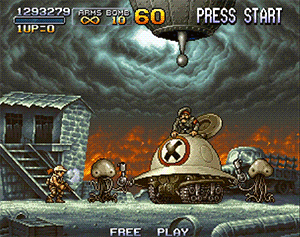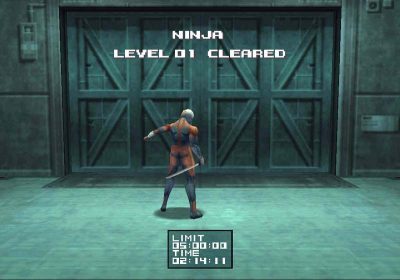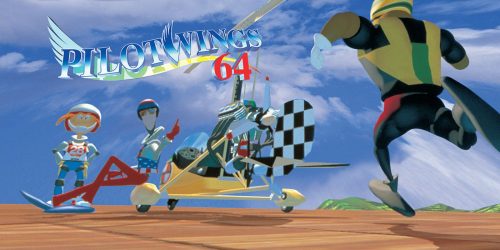Metal Slug Anthology – Visual Splendour and Fairness
May 23rd, 2020
Metal Slug’s greatest asset, its sumptuously animated take on warfare, works for and against the play experience. The games merit an infinite credit ‘free play’ run purely on the grounds of aesthetic feast. Each mission bursts to life with the hand-drawn exploits of befuddled military men, overly elaborate death animations, and richly coloured plumes of explosion. The juicy interactions provide a certain degree of sensory satisfaction and Metal Slug pushes the shooting and stabbing out at a high frequency.
However, the chaotic gunfights also generate visual clutter. Although Metal Slug adheres to some key principles of good 2D shooter design (i.e. brightly coloured bullets set against muted backdrops), the eruption of animation can obscure the play space when untamed, resulting in stray bullets finding their way through the noise to the player target. Fan-favourite Metal Slug 3 is perhaps the series’ worst offender in this regard.
Another consequence of the aesthetic feast is the limits placed on the player’s movement options. The first couple of missions in each game simplify the challenges by setting soldiers along a horizontal—sometimes hilly—plane. Sure, they can jump or perhaps swing in from a vine, but from a spatial perspective the gameplay challenges remain simple. As the missions roll on, the landforms emphasise both axes of 2D space; jumping challenges broaden the game’s palette beyond shooting and stabbing; and enemies begin to attack from both directions.
Metal Slug 1, 2, and X somewhat attempt to ease the player into this increased complexity. Their gameplay challenges are more tailored around distinct gameplay ideas, allowing the developers to organise them appropriately. The later games are much less consistent. Still, even considering the more grounded approach of the earlier games, the lack of space to move characterises the stricter second halves of the games. All too often, the on-screen action locks the player into a state of inevitable death.
This unfairness extends to other aspects of the games. Some challenges cannot be beaten with the default handgun (such as the train carriages in the fifth mission of MSX). Enemies can enter the screen and attack with limited warning, and similarly some boss attacks don’t telegraph—or have very short—windup. These problems chip away at the integrity of the gameplay challenges. As such, it can be hard to take the series seriously. Fortunately, Metal Slug Anthology offers the option to play each game with unlimited credits in ‘free play’ mode, an ideal way to survey the sumptuous sights of Metal Slug’s unique brand of disorganised warfare.
DP’s Games Crunch 2019 Part #2
January 12th, 2020
The turn of the decade has prompted me to revive this ‘year in review’-ish article series I began 11 years ago (has it been that long? Wow!). The list below catalogues my brief thoughts on the games I’ve completed over the past year.
Yoshi’s Story (N64)
Pretty bad for a Nintendo EAD game.
Mischief Makers (N64)
A Treasure game through and through. Inventive and diverse level concepts. Some are touch and go. Few outstay their welcome. Amazing boss battles. Tuning is 90% of the way there, but some extra polish would have been welcomed.
Killer Instinct Gold (N64)
I’ve always been attracted to KI’s distinctive character designs, but the combo system reduces the game to a static war over input strings.
1080 Snowboarding (N64)
As a mega fan of 1080 Avalanche, I wanted to love the original, but couldn’t execute a 1080 despite hours of practice. Failing to land particular jumps also marred the match race experience. A technical marvel which looks and runs far better on the Virtual Console than on original hardware.
English of the Dead (DS)
A fun curio I picked up when travelling in Japan earlier in the year.
Battalion Wars (GCN)
Like other genre mash-ups, Battalion Wars ends up having to compromise the strategy and third-person shooter essence to keep its gameplay together. Take for example, the challenges of balancing the early 2000s third-person camera and zoomed out strategy cam. The camera perspective during action gameplay limits the player’s view of the battlefield. With less information to work with, it becomes harder to make informed decisions and respond “just in time” to a constantly evolving game state. The unit design space and mission designs are great, but the aforementioned limitations shift the gameplay towards perspective management.
Battalion Wars is one of those games I invested a good deal of energy into, even though I recognise the weaknesses of the game’s design. Some friends and I recorded a super productive but yet-to-be-releasedi podcast working through the contradictions in BW’s design.
River City Ransom (NES)
Feels like a demake of the Yakuza games. People rightfully say that River City Ransom was ahead of its time. The secret kunio-kun game Nintendo World Cup was one of the first games I owned, so it was nice to see the same sprites and similar mechanics in their original manifestation.
Battletoads in Battlemaniacs (SNES)
Bad game. Contextual attacks interfere with the player’s agency. Story sequences make no sense. Bad 3D problems.
Superscope 6 (SNES)
Weird. Both the Blastris games are pitifully easy and barely warrant their own existence. On the hardest difficulty, Blastris A withholds the piece you need to win to artificially prompt a loss. Blastris B is super slow. Conversely, the two shooting games are pretty tough.
Super Punch-Out!! (SNES)
Super Punch-Out!!‘s sound effects, animation, and use of dramatic pauses are highly satisfying. However, fights need a dynamic element to diversify the scripted sequences and free the player’s learning process from dry rote.
The final two boxers broke the fairness test for me.
Super Metroid (SNES)
After subjecting myself to a number of rather strict and challenging titles this year, returning to Super Metroid reinvigorated my love for the medium. Most of my old SNES carts have kicked the bucket, but Super Metroid fittingly lives on.
It’s amazing that people put Symphony of the Night in the same sentence as Super Metroid. SOTN isn’t in the same league. Metroid’s room challenges are finely tuned and each unique within the game’s diverse palette of game concepts. Space and time play breathe dynamism into combat, with a strong foundation of aiming and moving through space. Unlike SoTN’s litany of abstractions, Super Metroid communicates its confrontations visually.
The atmosphere and macro level progression are medium-defining.
Metal Gear Solid: VR Missions (PS1)
One word: redundant. Metal Gear Solid’s design space is much broader than it is deep. VR Missions explores the nuance that is there, but it ain’t enough to substantiate a game of its length. A decent proportion of challenges are either arcanely nuanced or 100% gimmicky lolz (never on the level of Super Monkey Ball 2 crazy, though). Some challenges are super strict. Most others are a cakewalk. The slew of missions is fairly inconsistent.
The package’s nuanced-focused nature draws out quirky examples of poor tuning of game mechanics. For example, the way Snake holds out his left hand when holding a grenade makes him appear orientated slightly to one side. The contradicting visual reference makes it difficult to throw grenades straight.
The aiming is similar to Metroid: Other M, but Snake doesn’t register enemies as quickly and the bullets don’t home. Aiming from a distance is futile.
Final Update
In terms of my own writing, I spent the entirety of 2018 rewriting Adventures in Games Analysis and completing Speed Boost (both of which I endeavour to release this year). In 2019 I didn’t do any game-related writing, aside from some research for the next Game Design Companion book. Overhauling my original writing with the help of a professional editor was a laborious but necessary experience and I wanted to give myself a break before getting back in the game. In a few months, I hope to invest more time into the next GDC book.
DP’s Games Crunch 2019 Part #1
January 9th, 2020
The turn of the decade has prompted me to revive this ‘year in review’-ish article series I began 11 years ago (has it been that long?). The list below catalogues my brief thoughts on the games I completed over the past year.
Rhythm Thief (3DS)
Rhythm Thief feels unfinished. For some mini-games: button inputs don’t match rhythm, sound effects aren’t tuned to backing tracks, and the visuals don’t readily communicate how the player is supposed to act (R21 is a classic example). This is to say nothing of the mismatch between voice acting and text or the off-brand Professor Layton character design.
Space Invaders Extreme (PSP)
I was impressed by Space Invaders Extreme‘s ability to craft distinct gameplay concepts out of simple AI, enemy properties, and layered elements. It’s a superbly tuned game overall. One of my favourite shoot ’em ups. Difficulty needs to be toned down, though.
Groove Coaster (iOS)
An excellent visual concept carries much of this iOS rhythm game. The music is utterly amazing. The frequency of actions on the harder difficulties both erodes the integrity of the gameplay. A good case for stylus-based touch gameplay.
Onimusha (PS2)
A button-mashy Resident Evil-like. The fixed camera perspective obscures the relative distance between enemies and avatar. The similar Ninja Gaiden: Dragon Sword features a more substantial combat system.
Contra 4 (DS)
The spread shot and machine gun are pivotal to success in Contra 4 as the campaign is not tuned around the default pea shooter (mainly due to the layering of enemies making certain sections particularly strict). Each death forfeits the currently held weapon and so a single misstep can cull quite a number of lives. Hence, as mastery rolls forward, the player’s goal becomes one of minimising the aforementioned bumps in the road.
I completed 24/40 of Contra 4‘s challenge levels. The strict design (i.e. enemies everywhere, barely any room to move), inconsistent difficulty within each challenge, and lack of tuning (especially randomised enemy spawns) create a lot of needless repetition.
Super C (NES)
A refreshing antithesis which gets the balance right. Each level does something different with the core run n’ gun gameplay. I’m particularly fond of the Aliens references.
Contra (NES)
Not as polished as Super C and the bad 3D tunnel levels are a pain. Still better than Contra 4.
Mole Mania (GameBoy)
Mole Mania extracts a surprising amount of content out of its humble design space. By the end, the addition of puzzle-meddling enemies and an increased presence of complex, reading-focused puzzles take the lustre off this underappreciated gem. Not as good as Pax Softnica’s other two GameBoy gems, Balloon Kid and Donkey Kong 94.
Wolfenstein RPG + Doom 2 RPG (iOS)
Imagine the original games in a dungeon crawl format where the main gameplay loop is attack-attack-heal. Thoughtless.
Valkyrie Profile (PSP)
Props to Tri-Ace for creating a one-of-a-kind RPG in many respects (aesthetics, narrative, progression structure, combat system). The nuance-driven battle system skews more towards complex traditional RPG than Mario & Luigi. With few tutorials, I couldn’t get my head around some of the finer details of combat (even after hours of online research). Still, the timing-based combat system and frequent additions of new characters and abilities kept me with this one for some 30 hours. It’s a pity then that a major difficulty spike locked me out of the game around two thirds of the way through.
F-Zero X (N64)
I’ve written at length about F-Zero X for my upcoming book Speed Boost, so I don’t have much to say here aside from what I mentioned on Twitter:
After playing F-Zero X on the WiiU VC (which is the 60hz NTSC version), I tried my PAL cart and found that: X Cup and Master difficulty are unlocked from the start; there’s less input delay; and 50hz is super slow. In sum, it feels like a very different game.
Pilotwings (SNES)
Whilst an early technical feat for the Super Nintendo, the hardware restricts the simulation’s realism (and ability to render perspective) obscuring important cues needed to fly proficiently. As such, you often don’t have sufficient information to make informed decisions.
Pilotwings is more a game of landing than flying. The finnicky landing requirements dictate success and failure.
From best to worst vehicle: helicopter, rocket belt, sky diving, light plane, and glider.
Having to complete three missions in a row forces the player to retain more information (challenge complexities) over a longer period of time as they swap between each craft each mission. As such, one of Pilotwing’s main challenges is keeping all of your new learning in your head. Personally, I find that this requirement is a somewhat arbitrary.
Pilotwings 64 (N64)
If it weren’t for Super Metroid, this would be my favourite game of 2019. A number of factors greatly improve the playability of this sequel, namely the 3D rendering (ability to judge depth) and camera system (ability to survey maps pre-flight and adjust the camera mid-flight).
The game structure, where the player stays with the same craft and can repeat missions to improve their score, is conducive to sustained periods of practice where the player can familiarise themselves with the nuances of each challenge. This alteration suits Pilotwings 64’s challenges being longer, more diverse, and more sophisticated than the original game. Overall, the developers struck a good difficulty balance by increasing the skill ceiling, broadening the skill range, and allowing the player to repeat individual challenges.






 Game Design Companion: A Critical Analysis of Wario Land 4 - $7.99
Game Design Companion: A Critical Analysis of Wario Land 4 - $7.99 Level Design: Processes and Experiences
Level Design: Processes and Experiences Speed Boost: The Hidden Secrets Behind Arcade Racing Design - $5.99
Speed Boost: The Hidden Secrets Behind Arcade Racing Design - $5.99 Adventures in Games Analysis: Volume I - $5.99
Adventures in Games Analysis: Volume I - $5.99







